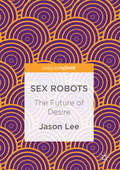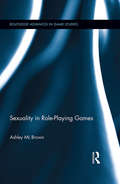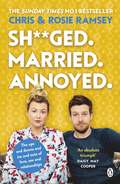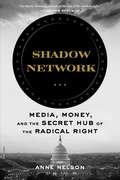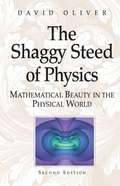- Table View
- List View
Sex Robots: The Future of Desire
by Jason LeeThis book reveals that the way we perceive sex robots is how we perceive ourselves, overcoming the false human/non-human binary. From Greek myths, to the film Ex Machina, to Japanese technology, non-human sexuality has been at the heart of culture. In Sex Robots, the history of this culture is explored. This text sheds new light on what the sex robot represents and signifies, examining its philosophical implications within the context of today's society. This volume will be of interest to scholars of technology, cultural studies, the social sciences and philosophy.
Sex, Technology and Public Health
by M. DavisExploring the implications of the internet and bio-technologies for intimate and sexual life, this book discusses the concept of citizenship in relation to the extension of public health through the internet, and reveals concerns that sexually transmitted infections and HIV are associated with such technologies.
Sexuality in Role-Playing Games (Routledge Advances in Game Studies)
by Ashley ML BrownRole-playing games offer a chance to pretend, make believe, and share fantasy. They often invoke heavy themes into their game play: morality, violence, politics, spirituality, or sexuality. Although interesting moral debates perennially appear in the media and academia concerning the appropriateness of games’ ability to deal with such adult concepts, very little is known about the intersection between games, playfulness, and sexuality and what this might mean for players. This book offers an in-depth, ethnographic look into the phenomenon of erotic role-play through the experiences of players in multiplayer and tabletop role-playing games. Brown explores why participants engage in erotic role-play; discusses the rules involved in erotic role-play; and uncovers what playing with sexuality in ludic environments means for players, their partners, and their everyday lives. Taken together, this book provides a rich, nuanced, and detailed account of a provocative topic.
Sexuality in Role-Playing Games (Routledge Advances in Game Studies)
by Ashley ML BrownRole-playing games offer a chance to pretend, make believe, and share fantasy. They often invoke heavy themes into their game play: morality, violence, politics, spirituality, or sexuality. Although interesting moral debates perennially appear in the media and academia concerning the appropriateness of games’ ability to deal with such adult concepts, very little is known about the intersection between games, playfulness, and sexuality and what this might mean for players. This book offers an in-depth, ethnographic look into the phenomenon of erotic role-play through the experiences of players in multiplayer and tabletop role-playing games. Brown explores why participants engage in erotic role-play; discusses the rules involved in erotic role-play; and uncovers what playing with sexuality in ludic environments means for players, their partners, and their everyday lives. Taken together, this book provides a rich, nuanced, and detailed account of a provocative topic.
Sexuelle Viktimisierung, Pornografie und Sexting im Jugendalter: Ausdifferenzierung einer sexualbezogenen Medienkompetenz (Medienbildung und Gesellschaft #37)
by Verena VogelsangVerena Vogelsang untersucht mittels einer explorativ ausgerichteten Studie, über welche Kenntnisse, Fähigkeiten und Einstellungen Jugendliche im Umgang mit Pornografie, sexueller Viktimisierung in Onlinekommunikation und Sexting verfügen. Die Ergebnisse liefern einen tiefen Einblick in die sexuelle Sozialisation im digitalen Zeitalter und leisten einen zentralen Beitrag zur Ausdifferenzierung einer sexualbezogenen Medienkompetenz. Die Nutzung von Pornografie und Sexting wird dabei nicht ausschließlich als Risiko betrachtet. Vielmehr rücken ebenfalls die Nutzungspotenziale sexueller Medieninhalte, Kommunikations- und Interaktionsformen in den Blick.
SFML Blueprints
by Maxime BarbierThis book is for developers who have knowledge of the basics of the SFML library and its capabilities in 2D game development. Minimal experience with C++ is required.
SFML Essentials
by Milcho G. MilchevIf you are an enthusiast who is not new to the field of game development but want to exercise the countless features of SFML and build 2D games with minimal effort, this is the book for you.
SFML Game Development
by Jan Haller Henrik Vogelius Hansson Artur MoreiraSFML Game Development is a fast-paced, step-by-step guide, providing you with all the knowledge and tools you need to create your first game using SFML 2.0.SFML Game Development addresses ambitious C++ programmers who want to develop their own game. If you have plenty of ideas for an awesome and unique game, but don't know how to start implementing them, then this book is for you. The book assumes no knowledge about SFML or game development, but a solid understanding of C++ is required.
SFML Game Development By Example
by Raimondas PupiusCreate and develop exciting games from start to finish using SFML About This Book • Familiarize yourself with the SFML library and explore additional game development techniques • Craft, shape, and improve your games with SFML and common game design elements • A practical guide that will teach you how to use utilize the SFML library to build your own, fully functional applications Who This Book Is For This book is intended for game development enthusiasts with at least decent knowledge of the C++ programming language and an optional background in game design. What You Will Learn • Create and open a window by using SFML • Utilize, manage, and apply all of the features and properties of the SFML library • Employ some basic game development techniques to make your game tick • Build your own code base to make your game more robust and flexible • Apply common game development and programming patterns to solve design problems • Handle your visual and auditory resources properly • Construct a robust system for user input and interfacing • Develop and provide networking capabilities to your game In Detail Simple and Fast Multimedia Library (SFML) is a simple interface comprising five modules, namely, the audio, graphics, network, system, and window modules, which help to develop cross-platform media applications. By utilizing the SFML library, you are provided with the ability to craft games quickly and easily, without going through an extensive learning curve. This effectively serves as a confidence booster, as well as a way to delve into the game development process itself, before having to worry about more advanced topics such as “rendering pipelines” or “shaders.” With just an investment of moderate C++ knowledge, this book will guide you all the way through the journey of game development. The book starts by building a clone of the classical snake game where you will learn how to open a window and render a basic sprite, write well-structured code to implement the design of the game, and use the AABB bounding box collision concept. The next game is a simple platformer with enemies, obstacles and a few different stages. Here, we will be creating states that will provide custom application flow and explore the most common yet often overlooked design patterns used in game development. Last but not the least, we will create a small RPG game where we will be using common game design patterns, multiple GUI. elements, advanced graphical features, and sounds and music features. We will also be implementing networking features that will allow other players to join and play together. By the end of the book, you will be an expert in using the SFML library to its full potential. Style and approach An elaborate take on the game development process in a way that compliments the reader's existing knowledge, this book provides plenty of examples and is kind to the uninitiated. Each chapter builds upon the knowledge gained from the previous one and offers clarifications on common issues while still remaining within the scope of its own subject and retaining clarity.
The SGML FAQ Book: Understanding the Foundation of HTML and XML (Electronic Publishing Series #7)
by S.J. DeRoseAlthough not evident to all, many people have been waiting more than a decade for The SGML FAQ Book by Steve DeRose. It has been "brewing" for a long time, with many hours, months, years of research talking to people, gathering their ideas, listening to their frustrations, applauding their successes. Only Steve with his experience, credentials, wit, and enthusiasm for the subject could have written this book. But it is also a measure of the success and maturity of ISO 8879 and its amazing longevity that allows an "SGMLer" to write such a book. We can now laugh at ourselves, even disclose our mistakes without fear of the other guy. While most would not recognize it, the revolution known as the World Wide Web would not have happened without a non-proprietary, easy, and almost "portable way to create and distribute documents across a widely disparate set of computers, networks, even countries. HTML, an SGML application, enabled this and as a result the world and the SGML community will never be the same. For some the term SGML means order, management, standards, discipline; to others, the term brings images of pain, confusion, complexity, and pitfalls. To all who have engaged in it, the Standard means hard work, good friends, savings in terms of time, money, and effort, a sense of accomplishment and best of all - fun. This book adds immeasurably to all of these. Enjoy the quote from Through Looking by Lewis Carroll as much as we have.
SGML für die Praxis: Ansatz und Einsatz von ISO 8879 (Edition PAGE)
by Wolfgang RiegerOrientierungsgrundlage für Entscheidungsträger und Basiswissen für Entwickler: beides bietet dieser praxisorientierte Einstieg in die Anwendungsmöglichkeiten von SGML. Zahlreiche Beispiele veranschaulichen die Dokument-Typ-Definition. Ein praktischer Überblick informiert über die verfügbare SGML-Software. Concise text: Praxisorientiert und anschaulich informiert der Autor über die Anwendungsgebiete von SGML, die Dokument-Typ-Definitionen und die verfügbare SGML-Software.
The SGML Implementation Guide: A Blueprint for SGML Migration
by Brian E. Travis Dale C. WaldtForeword------------------------------------- SGML is misunderstood and underestimated. I have always wanted to write this book. I am pleased that two people with whom I have had the pleasure to work were finally able to do so. Since I have always been a bit of an evangelist, I feel pride when my "students" become recognized "teachers". In the early years of SGML we struggled to define a language that would bring the information to its rightful place. We succeeded. Then we had to explain these idea to technical adoptors. Again, I think we have succeeded. We have learned much about SGML in the process of implementing it. These experiences must now also be shared, along with comprehensible information on the lan guage itself. The word must move out of the lab and the computer center and reach the business people, the users, the movers and shakers. The next generation will do things with SGML that we can't even imagine yet- it is that versatile.
SGML und XML: Anwendungen und Perspektiven
by Wiebke Möhr Ingrid SchmidtSGML und XML sind fundamentale Konzepte der heutigen und künftigen Speicherung, Verarbeitung und Verbreitung langlebiger Informationen, gerade im Hinblick auf die weltweite Vernetzung durch das Internet. Ausgehend von den technischen und ökonomischen Herausforderungen unserer Informationsgesellschaft, stellen die Autoren die wichtigen Entwicklungen dar und berichten über aktuelle Projekte mit SGML- und XML-Anwendungen in der Praxis. Das Buch wendet sich an das Management informationsverarbeitender und -produzierender Unternehmen, an die Technik-Verantwortlichen und SGML-/XML-Anwender sowie an Studierende informationsverarbeitender Fächer und der Informatik.
Sh**ged. Married. Annoyed.: The Sunday Times No. 1 Bestseller
by Chris Ramsey Rosie RamseyTHE HILARIOUS AND ACHINGLY RELATABLE NEW BOOK FROM CHRIS AND ROSIE RAMSEY, STARS OF THE CHART-TOPPING PODCASTThis is not a self-help book. This book contains absolutely no advice that you should follow yourself. ___________SH**GED Saturday nights out on the tiles, undying crushes, dating like it's a competitive sport, awkward tales of dating woes, one-night stands, the walk of shame, ghosting, tears and break-ups.MARRIED Finding 'the one', meeting their parents, first holidays and romantic weekends away, engagement rings, big moment proposals, wedding bells, the hen do, the stag, the much anticipated - and feared - best man speech, the honeymoon of a lifetime.ANNOYED Who stacks a dishwasher like this? Empty milk cartons placed back into the fridge, pregnancy, sleepless nights, toilet seats up, toothpaste everywhere, less and less frequent date nights, DIY weekends, divorce.Whether you're sh**ged, married, annoyed, or, all of the above, Chris and Rosie Ramsey, hosts of the number one podcast, write hilariously and with honesty about the ups and downs and ins and outs of love, sex and relationships.
Shader Writing in Open Shading Language: With RenderMan® Examples
by Mitch J. PraterIncorporating both historical techniques and the most recent developments in computer graphics, Shader Writing in Open Shading Language is a treatise on OSL shader writing and shader development that intends to remedy the current lack of material on this important area of technical and artistic expertise. It is for artists who wish to know more about shaders and shader writing, for programmers who want the ultimate in creative control, or for anyone in‑between.It begins by covering the entire range of independent variables upon which all shaded pattern generation is based. From that foundation, every fundamental procedural, textural, conversion, and pattern modification shader category is described with clear and practical examples.Each topic is presented in a progression of chapters that begin with the fundamentals and expand to more complex shaders illustrating more advanced techniques that build on the previously covered material.In addition, these important topics are also covered: Shader user interface design and parameter widgets Color, color models, color spaces, and color transformations 2d and 3d spaces and their transformations Texture patterns and projections Ray tracing for pattern generation Displacement and bumped shading normal generation Shader organization, building, and deployment Shader execution and debugging
Shader Writing in Open Shading Language: With RenderMan® Examples
by Mitch J. PraterIncorporating both historical techniques and the most recent developments in computer graphics, Shader Writing in Open Shading Language is a treatise on OSL shader writing and shader development that intends to remedy the current lack of material on this important area of technical and artistic expertise. It is for artists who wish to know more about shaders and shader writing, for programmers who want the ultimate in creative control, or for anyone in‑between.It begins by covering the entire range of independent variables upon which all shaded pattern generation is based. From that foundation, every fundamental procedural, textural, conversion, and pattern modification shader category is described with clear and practical examples.Each topic is presented in a progression of chapters that begin with the fundamentals and expand to more complex shaders illustrating more advanced techniques that build on the previously covered material.In addition, these important topics are also covered: Shader user interface design and parameter widgets Color, color models, color spaces, and color transformations 2d and 3d spaces and their transformations Texture patterns and projections Ray tracing for pattern generation Displacement and bumped shading normal generation Shader organization, building, and deployment Shader execution and debugging
Shading, Lighting, and Rendering with Blender's EEVEE: Learn how to create and iterate amazing concept art using a real-time rendering engine
by Sammie CrowderGet to grips with new real-time animation techniques and tricks to improve both your artistic and technical skills in shading, 3D rendering, lighting, and scene creation using Blender 3.0Key FeaturesLearn real-time rendering engine concepts by creating three projectsUnderstand how to update workflows to Blender 3.0Explore intermediate to advanced-level tutorials on creating art inside BlenderBook DescriptionBlender is one of the most important emerging 3D software packages in the world. Anyone can download the software, and with millions of tutorials on YouTube and elsewhere, learn how to use it. EEVEE, a state-of-the-art, real-time rendering engine, is a fairly new addition to Blender and provides you with the capacity to quickly iterate on the artwork, allowing you to rapidly create, modify, and produce quality renders.This book provides a high-level overview of what EEVEE is capable of and then takes you through the steps of creating three professional-quality artworks in three unique styles. As you progress, you'll discover new techniques added in Blender 3.0, ways to add life to your renders, and mind-blowing shortcuts that will allow you to take your artwork to the next level.By the end of this Blender book, you'll have created three separate works that will have challenged you to design and iterate with the full power of Blender EEVEE.What you will learnExplore EEVEE Render Properties for optimal outcomesFocus on shading processes, including those that are both traditional and more cutting-edgeUnderstand composition and create effective concept art inside BlenderDiscover procedural workflows to shorten the artistic process instead of getting mired in detailsUnderstand intermediate Blender workflows for working in a professional environmentDevelop art in different styles and learn why each style has different workflows and conventionsCreate interactive, rapid changes in Blender's EEVEE engineWho this book is forThis book is for 3D animators, sculptors, modelers, and concept artists who want to use EEVEE to speed up their work in movies, TV, and game design. Readers are expected to have a basic to intermediate-level understanding of 3D programs and ray-tracing engines.
Shadow Algorithms Data Miner
by Andrew Woo Pierre PoulinShadow Algorithms Data Miner provides a high-level understanding of the complete set of shadow concepts and algorithms, addressing their usefulness from a larger graphics system perspective. It discusses the applicability and limitations of all the direct illumination approaches for shadow generation.With an emphasis on shadow fundamentals, the boo
Shadow Network: Media, Money, and the Secret Hub of the Radical Right
by Anne Nelson“Reveals a political trend that threatens both our form of government and our species.” - Timothy Snyder, author of ON TYRANNY"Riveting.... Want to understand how so many Americans turned against truth? Read this book." Nancy Maclean, author of DEMOCRACY IN CHAINSThe chilling story of the covert group that masterminds the Radical Right's ongoing assault on America's airwaves, schools, environment, and, ultimately, its democracy. In 1981, emboldened by Ronald Reagan's election, a group of some fifty Republican operatives, evangelicals, oil barons, and gun lobbyists met in a Washington suburb to coordinate their attack on civil liberties and the social safety net. These men and women called their coalition the Council for National Policy. Over four decades, this elite club has become a strategic nerve center for channeling money and mobilizing votes behind the scenes. Its secretive membership rolls represent a high-powered roster of fundamentalists, oligarchs, and their allies, from Oliver North, Ed Meese, and Tim LaHaye in the Council's early days to to Kellyanne Conway, Ralph Reed, Tony Perkins, and the DeVos and Mercer families today. In Shadow Network, award-winning author and media analyst Anne Nelson chronicles this astonishing history and illuminates the coalition's key figures and their tactics. She traces how the collapse of American local journalism laid the foundation for the Council for National Policy's information war and listens in on the hardline broadcasting its members control. And she reveals how the group has collaborated with the Koch brothers to outfit Radical Right organizations with state-of-the-art apps and a shared pool of captured voter data - outmaneuvering the Democratic Party in a digital arms race whose result has yet to be decided.In a time of stark and growing threats to our most valued institutions and democratic freedoms, Shadow Network is essential reading.
Shadowing in Dynamical Systems: Theory and Applications (Mathematics and Its Applications #501)
by K.J. PalmerIn this book the theory of hyperbolic sets is developed, both for diffeomorphisms and flows, with an emphasis on shadowing. We show that hyperbolic sets are expansive and have the shadowing property. Then we use shadowing to prove that hyperbolic sets are robust under perturbation, that they have an asymptotic phase property and also that the dynamics near a transversal homoclinic orbit is chaotic. It turns out that chaotic dynamical systems arising in practice are not quite hyperbolic. However, they possess enough hyperbolicity to enable us to use shadowing ideas to give computer-assisted proofs that computed orbits of such systems can be shadowed by true orbits for long periods of time, that they possess periodic orbits of long periods and that it is really true that they are chaotic. Audience: This book is intended primarily for research workers in dynamical systems but could also be used in an advanced graduate course taken by students familiar with calculus in Banach spaces and with the basic existence theory for ordinary differential equations.
Shadows and Silhouettes in Computer Vision (The Springer International Series in Engineering and Computer Science #3)
by S.A. ShaferThe Shaggy Steed of Physics: Mathematical Beauty in the Physical World
by David OliverThe Shaggy Steed is an unassuming figure from Irish folklore who reveals himself as an inspiring teacher of the forces hidden in the universe. This book celebrates an unassuming bit of physics that also turns out to be an inspiring teacher. The two-body problem - the motion of two bodies bound by the inverse-square force of gravity and electricity - is the Shaggy Steed of physics, guiding the reader to an understanding of both the forces and the mathematical beauty hidden in the physical world.
The Shaggy Steed of Physics: Mathematical Beauty in the Physical World
by David OliverThe Shaggy Steed is an unassuming figure from Irish folklore who reveals himself as an inspiring teacher of the forces hidden in the universe. This book celebrates an unassuming bit of physics that also turns out to be an inspiring teacher. The two-body problem - the motion of two bodies bound by the inverse-square force of gravity and electricity - is the Shaggy Steed of physics, guiding the reader to an understanding of both the forces and the mathematical beauty hidden in the physical world.
Shale Analytics: Data-Driven Analytics in Unconventional Resources
by Shahab D. MohagheghThis book describes the application of modern information technology to reservoir modeling and well management in shale. While covering Shale Analytics, it focuses on reservoir modeling and production management of shale plays, since conventional reservoir and production modeling techniques do not perform well in this environment. Topics covered include tools for analysis, predictive modeling and optimization of production from shale in the presence of massive multi-cluster, multi-stage hydraulic fractures. Given the fact that the physics of storage and fluid flow in shale are not well-understood and well-defined, Shale Analytics avoids making simplifying assumptions and concentrates on facts (Hard Data - Field Measurements) to reach conclusions. Also discussed are important insights into understanding completion practices and re-frac candidate selection and design. The flexibility and power of the technique is demonstrated in numerous real-world situations.
Shall We Play the Festschrift Game?: Essays on the Occasion of Lauri Carlson's 60th Birthday
by Diana Santos, Krister Lindén and Wanjiku Ng’ang’aThere are not many people who can be said to have influenced and impressed researchers in so many disparate areas and language-geographic fields as Lauri Carlson, as is evidenced in the present Festschrift. His insight and acute linguistic sensitivity and linguistic rationality have spawned findings and research work in many areas, from non-standard etymology to hardcore formal linguistics, not forgetting computational areas such as parsing, terminological databases, and, last but not least, machine translation. In addition to his renowned and widely acknowledged insights in tense and aspect and its relationship with nominal quantification, and his ground-breaking work in dialog using game-theoretic machinery, Lauri has in the last fifteen years as Professor of Language Theory and Translation Technology contributed immensely to areas such as translation, terminology and general applications of computational linguistics. The three editors of the present volume have successfully performed doctoral studies under Lauri’s supervision, and wish with this volume to pay tribute to his supervision and to his influence in matters associated with research and scientific, linguistic and philosophical inquiry, as well as to his humanity and friendship.
